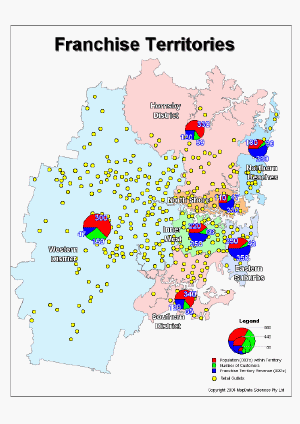AGS, which started as a company providing trade services in Sydney, Australia, is one of the only franchise groups in Australia to offer trade services.It includes seven operators today who provide electrical repair and installation, telephone and data cabling and air conditioning services.So they were very much in need of digital mapping to help them market their franchises.( AGS also has a web site through which it sells air conditioning systems nationally.)
"The information delivered by mapping territories using digital technology is critical to our contracts," said Mahony, who launched the trade services group in 1988."We use digital mapping to ensure the 100 percent correct definition and allocation of franchise territories and therefore to meet the demands of our contracts." As new mapping data has become available, AGS has redrawn franchise territories to benefit the growing numbers of trades people who had purchased a franchise.
Fullick, who joined AGS in 1995, explained that they decided to expand through franchising when the growing demand for trade services coincided with a decline in the number of tradesmen entering the industry.AGS's advertising and other promotional activities are geared at generating about 2,500 jobs a year through a call centre.Its customers range from major public facilities, chains of retail outlets to individual businesses and householders.
At the outset both directors recognised that successfully franchising the provision of trade services would be based on the accurate delineation of territories.So, initially they began to collect data by themselves from various sources to define those territories, including local government, business listings and post code data.This was a mammoth task, but proved to be an important experience in highlighting some of the discrepancies AGS would encounter in understanding mapping data.
For example, while separate AGS franchise territories could not straddle different post code areas, research uncovered instances where the same post code was shared by two areas that were 10 kilometres apart! This became obvious when maps were displayed on a screen.
"We came to realise quickly that 'manual' mapping methods were inappropriate in ensuring that the territory offered an appropriate volume of potential business.Without this assurance neither we nor a franchise could meet the terms of our contracts," Fullick said.
The initial 'manual' exercise prompted AGS to use digital mapping services from Sydney company MapData Sciences (MDS).Mahony and Fullick chose consulting services rather than buying the software because no one would need to be trained to use the mapping technology, and they wouldn't have to go to the expense and effort of ensuring the ongoing currency and quality of the underlying data.
As newer data became available
from various sources, the mapping project was refined.
Some of the data used to
initially define the franchise territories came from the 1996 Census.
AGS realised that the initial
franchise territories were in fact too large.In 2002, based on Census
data from the preceding year, it redefined franchise areas.Consequently
the number of areas almost doubled, from 24 to 46.People who purchased
original, larger franchise areas were given the option of acquiring the
smaller sub-divided territories.
Franchise territories are defined within certain post code areas as having a population of between 100,000 and 200,000 people, 50,000 houses and between 5,000 and 10,000 businesses.(Click image for larger view.)
Mahony recommends a franchiser develop a basic understanding of the logic of digital mapping and how it works to understand how it accommodates certain apparent discrepancies. Sheer geographic size can be deceptive.While it is a large area, Sydney's northern beaches from Manly to Palm Beach for example, is only one territory. This contrasts with other much smaller geographical territories.
"The major question one must ask is: is there sufficient potential business in the area under consideration? The last thing the franchiser needs is the failure of an area through it having insufficient business potential," Mahony said.
AGS actively promotes its use of mapping to potential franchisees.They are able to view their territory on a map and can be confident of the business viability of that territory, based on the demographic and other data that supports it.They look at three fundamental sets of data related to any given geographic area: the number of households, businesses and competitors.They determine the likely volume of business they could expect to generate from households and businesses in a particular area and then subtract the amount of competition expected from companies and individual providers of the range of trades services that it offers.
"We researched the broad
principles of the franchise model by visiting the US, as well as several
countries.While sheer population size dictates different approaches to
franchise model in the US, the mapping technology as provided by MDS consulting
services to support our approach is first class," Fullick said.
